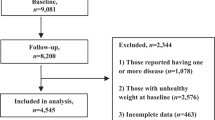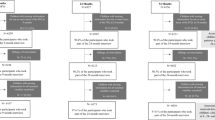Abstract
Background/Objectives:
To study nutrient intake, food consumption and meal pattern, and their associations with socioeconomic background in Finnish children.
Subjects/Methods:
The subjects were a population sample of 424 children (211 girls, 213 boys) 6–8 years of age. Nutrient intake and meal pattern were measured by food records, and food intake and socioeconomic characteristics were assessed by questionnaires.
Results:
Intakes of saturated fat, sucrose and salt were higher, and intakes of vitamin D, iron and fibre and unsaturated-to-saturated fat ratio lower than recommended. Less than 5% of children consumed vegetables, fruit and berries as recommended. Children with highest parental education more likely ate fish (odds ratio (OR) 2.20, 95% confidence interval (CI) 1.06–4.54), fibre-rich bread (OR 5.06, 95% CI 1.80–14.29) and main meals (OR 2.54, 95% CI 1.34–4.83), but less likely used soft margarine (OR 0.43, 95% CI 0.20–0.94) as recommended than children with lowest parental education. Children with highest household income more likely consumed skimmed milk (OR 2.43, 95% CI 1.21–4.88) and fish (OR 2.21, 95% CI 1.12–4.36) as recommended than children with lowest household income. Only 34% of girls and 45% of boys ate all main meals daily. Snacks provided as much as 42% of total energy intake.
Conclusions:
Children do not meet recommendations in all important nutrients. Children from lowest socioeconomic position least likely consumed fish, skimmed milk and fibre-rich bread and ate main meals, but most likely used soft margarine as recommended. Less than half of children ate all main meals daily.
This is a preview of subscription content, access via your institution
Access options
Subscribe to this journal
Receive 12 print issues and online access
$259.00 per year
only $21.58 per issue
Buy this article
- Purchase on Springer Link
- Instant access to full article PDF
Prices may be subject to local taxes which are calculated during checkout

Similar content being viewed by others
References
Adams J, O'Keeffe M, Adamson A (2005). Change in snacking habits and obesity over 20 years in children aged 11 to 12 years. Project code NO9019. Final report to Food Standards Agency. http://www.foodbase.org.uk//admintools/reportdocuments/86_140_N09019_Final_report_FSA_amended_accepted.pdf.
Buzzard M (1998). 24-h dietary recall and food record methods. In: Willett W (ed). Nutritional Epidemiology. Oxford University Press: New York, pp 50–73.
Croezen S, Visscher TL, Ter Bogt NC, Veling ML, Haveman-Nies A (2009). Skipping breakfast, alcohol consumption and physical inactivity as risk factors for overweight and obesity in adolescents: results of the E-MOVO project. Eur J Clin Nutr 63, 405–412.
Erkkilä A, de Mello VD, Risérus U, Laaksonen DE (2008). Dietary fatty acids and cardiovascular disease: an epidemiological approach. Prog Lipid Res 47, 172–187.
Erkkola M, Kronberg-Kippilä C, Kyttälä P, Lehtisalo J, Reinivuo H, Tapanainen H et al. (2009). Sucrose in the diet of 3-year-old Finnish children: sources, determinants and impact on food and nutrient intake. Br J Nutr 101, 1209–1217.
Haapalahti M, Mykkänen H, Tikkanen S, Kokkonen J (2003). Meal patterns and food use in 10- to 11-year-old Finnish children. Public Health Nutr 6, 365–370.
Hirvonen T, Männistö S, Roos E, Pietinen P (1997). Increasing prevalence of underreporting does not necessarily distort dietary surveys. Eur J Clin Nutr 51, 297–301.
Hoppu U, Kujala J, Lehtisalo J, Tapanainen H, Pietinen P (eds) (2008). Nutrition and Wellbeing of Secondary School Pupils. Situation and Results of the Intervention Study During Academic Year 2007–2008. Publications of the National Public Health Institute, B30/2008: Helsinki, Finland.
King DE (2005). Dietary fiber, inflammation, and cardiovascular disease. Mol Nutr Food Res 25, 594–600.
Kyttälä P, Ovaskainen M, Kronberg-Kippilä C, Erkkola M, Tapanainen H, Tuokkola J et al. (2008). The Diet of Finnish Preschoolers. Publications of the National Public Health Institute B32/2008: Helsinki.
Laitinen S, Räsänen L, Viikari J, Åkerblom HK (1995). Diet of Finnish children in relation to the family's socio-economic status. Scand J Soc Med 23, 88–94.
Macdiarmid J, Loe J, Craig LC, Masson LF, Holmes B, McNeill G (2009). Meal and snacking patterns of school-aged children in Scotland. Eur J Clin Nutr 63, 1297–1304.
Mikkilä V, Räsänen L, Raitakari OT, Pietinen P, Viikari J (2005). Consistent dietary patterns identified from childhood to adulthood: The Cardiovascular Risk in Finns Study. Br J Nutr 93, 923–931.
Moreno LA, Rodriguez G (2007). Dietary risk factors for development of childhood obesity. Curr Opin Clin Nutr Metab Care 10, 336–341.
National Nutrition Council (2005). Finnish Nutirition Recommendations. Edita Prima Oy: Helsinki.
National Nutrition Council (2008). The Recommendations for School Meals. Savion Kirjapaino Oy: Helsinki. Available in Finnish.
Nicklas TA, Bao W, Webber LS, Berenson GS (1993). Breakfast consumption affects adequacy of total daily intake in children. J Am Diet Assoc 93, 886–891.
Nordic Council of Ministers (2004). Nordic Nutrition Recommendations 2004. Integrating Nutrition and Physical Activity, 4th edn. Nord: Copenhagen, p 13.
Rampersaund GC, Pereira MA, Girard BL, Adams J, Metzl JD (2005). Breakfast habits, nutritional status, body weight, and academic performance in children and adolescents. J Am Diet Assoc 105, 743–760.
Rastas M, Seppänen R, Knuts LR, Karvetti RL, Varo P (eds) (1993). Nutrient Composition of Foods. Publications of the Social Insurance Institution: Helsinki.
Ruottinen S, Lagström HK, Niinikoski H, Rönnemaa T, Saarinen M, Pahkala KA et al. (2010). Dietary fiber does not displace energy but is associated with decreased serum cholesterol concentrations in healthy children. Am J Clin Nutr 91, 651–661.
Ruottinen S, Niinikoski H, Lagström H, Rönnemaa T, Hakanen M, Viikari J et al. (2008). High sucrose intake is associated with poor quality of diet and growth between 13 months and 9 years of age: the special Turku Coronary Risk Factor Intervention Project. Pediatrics 121, e1676–e1685.
Sjöberg A, Hallberg L, Höglund D, Hulthén L (2003). Meal pattern, food choice, nutrient intake and lifestyle factors in The Göteborg Adolescence Study. Eur J Clin Nutr 57, 1569–1578.
Strazzullo P, D'Elia L, Kandala NB, Cappuccio FP (2009). Salt intake, stroke, and cardiovascular disease: meta-analysis of prespective studies. BMJ 339, b4567.
Talvia S, Lagström H, Räsänen M, Salminen M, Räsänen L, Salo P et al. (2004). A randomized intervention since infancy to reduce intake of saturated fat. Calorie (energy) and nutrient intakes up to the age of 10 years in the Special Turku Coronary Factor Intervention Project. Arch Pediatr Adolesc Med 158, 41–47.
Torun B, Davies P, Livingstone MBE, Paolisso M, Sackett R, Spurr GB (1996). Energy requirements and dietary energy recommendations for children and adolescents 1 to 18 years old. Eur J Clin Nutr 50 (Suppl 1), S37–S81.
Touger-Decker R, van Loveren C (2003). Sugars and dental caries. Am J Clin Nutr 78, S881–S892.
Wang Y, Bentley ME, Zhai F, Popkin BM (2002). Tracking of dietary intake patterns of Chinese from childhood to adolescence over a six-year follow-up period. J Nutr 132, 430–438.
Würbach A, Zellner K, Kromever-Hauschild K (2009). Meal patterns among children and adolescents and their associations with weight status and parental characteristics. Public Health Nutr 12, 1115–1121.
Acknowledgements
We thank the voluntary subjects and their families who participated in this study. We are also gratefully indebted to the PANIC Study research team members for their skillful contribution in performing the study. This work has been financially supported by grants from the Ministry of Social Affairs and Health of Finland, the Ministry of Education of Finland, the University of Kuopio, the Finnish Innovation Fund Sitra, the Social Insurance Institution of Finland, the Finnish Cultural Foundation, the Juho Vainio Foundation, the Foundation for Paediatric Research and the Kuopio University Hospital EVO.
Author information
Authors and Affiliations
Corresponding author
Ethics declarations
Competing interests
The authors declare no conflict of interest.
Rights and permissions
About this article
Cite this article
Eloranta, A., Lindi, V., Schwab, U. et al. Dietary factors and their associations with socioeconomic background in Finnish girls and boys 6–8 years of age: the PANIC Study. Eur J Clin Nutr 65, 1211–1218 (2011). https://doi.org/10.1038/ejcn.2011.113
Received:
Revised:
Accepted:
Published:
Issue Date:
DOI: https://doi.org/10.1038/ejcn.2011.113
Keywords
This article is cited by
-
Interaction between genetic susceptibility to obesity and food intake on BMI in Finnish school-aged children
Scientific Reports (2023)
-
Child-related and parental predictors for thelarche in a general population of girls: the PANIC study
Pediatric Research (2020)
-
Identifying eating habits in Finnish children: a cross-sectional study
BMC Public Health (2019)
-
Genetic predisposition to higher body fat yet lower cardiometabolic risk in children and adolescents
International Journal of Obesity (2019)
-
Diet quality and academic achievement: a prospective study among primary school children
European Journal of Nutrition (2017)



